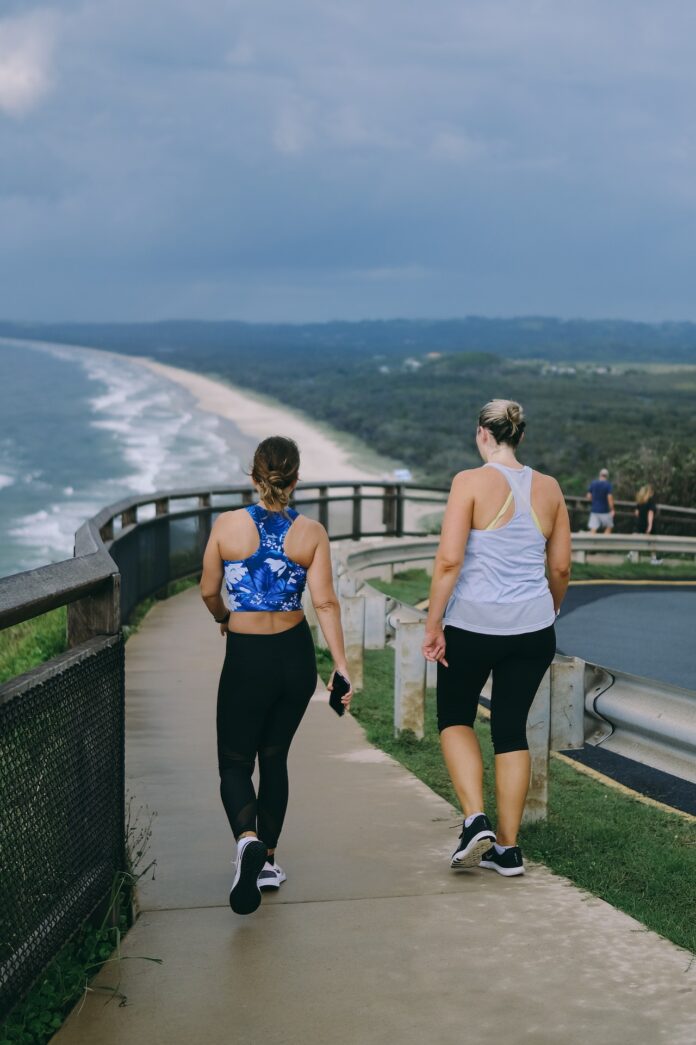UK Google searches for a “Walking workout” continue to surge, most recently by 1500%, as Brits are seeking a lower intense form of fitness which helps maintain fitness levels, whilst avoiding risk of injury or fatigue.
The ‘walking workout’ is also currently trending on TikTok, with the #walkingworkout hashtag racking up 51.6 million views on the app and counting.
According to the NHS website, “walking briskly can help you build stamina, burn excess calories and make your heart healthier.”
Abigail Roberts, Sports Nutritionist at bulk.com, shares why a walking workout can be a better choice than HIIT for certain people and the overall benefits of a walking workout.
What is a walking workout and what are the benefits?
“Walking is a type of cardiovascular physical activity, often performed at a moderate-low intensity, that does not exert excess strain on joints which are susceptible to injury.
“A walking workout is often used by someone who wants to moderately become more physically active, and ideal for people of all ages and fitness levels.”
“Walking is just as good as any other exercise and setting yourself a goal of completing a ‘walking workout’ can be more motivating than just walking here and there throughout
the day.
“Completing a ‘walking workout’, whether it be outdoors or on the treadmill, can aid in weight loss and provide health benefits such as reducing stress and anxiety, improving mood and overall feelings of wellbeing.
“For those who don’t love going to the gym, a lower-intensity walking workout can seem more appealing and may not leave you feeling too fatigued to perform other exercises.”
Where do I start with a walking workout routine?
“An hour of light to moderate walking per day is ideal for a walking workout. Walking at a moderate pace of 3 mph equals an average of 6,000 steps per hour, so you could set yourself a step target of 6,000 steps per day.
“Breathing in through the nose and out through the mouth can help to moderate a steady heart rate and help you remain calm and in control.”
“For an outdoor walking workout, it is good to set yourself a route and record your activity on your phone or smart watch, as this can show how many calories you burn and why you don’t always have to go to a gym to do a workout.
“Walking for just one hour every day can help decrease the rate of depression, boosts your mood, gives you energy, and helps reduce anxiety- according to research.”
When to choose a walking workout over a HIT workout?
“Higher-impact workouts are more susceptible to injury of joint such as hips, knees and ankles, and can also raise heart rate.
“For someone who is recovering from injury, has joint problems, or is fairly new to exercise, starting with a low–intense walking workout is much better.
“Also, for someone who may have a heart condition, it is important to stick to low intense activity, to ensure you don’t push your heart too much.
“Low-impact exercise also put less stress on your body, and reduces the need for rest days, helping you remain consistently active. Also, opt for lower intensity to avoid potential injury or a high heart rate.
“Elderly adults are naturally more vulnerable to developing heart conditions, therefore The Centre for Disease Control recommends that healthy adults over the age of 65 should try to complete 150 minutes of low to moderate intensity cardio activity once a week.”
Below, Abigail Roberts from bulk.com shares her step-by-step guide for integrating a walking workout into your everyday routine:
Step 1– Warm up
Before any form of exercise, you should always warm up.
This consists of 5-10 minutes of light stretching exercises, from leg swings, arm circles, and head rotations.
An initial brisk walk can also be done for a couple of minutes to gradually increase your heart rate.
Step 2– Set your goal
Depending on the results you would like from your walking workout, you can set a goal of a desired intensity and duration.
For beginners, we recommend starting with 20 to 30-minute walk at a moderate pace. You can then increase your duration or intensity depending on how comfortable you feel.
Step 3- Choose a route
Setting yourself a route will help you begin your walking workout routine
Whether it is through your local park, along the beach or through the woods, choosing a route with nice scenery always helps you walk feel enjoyable.
Expert top tip: remember to consider any safety factors that could potentially hinder you on your tracks. You may want to do a trial walk to ensure the route is right for you.
Step 4– Record your activity
Recording your activity will show you just how many calories you will burn with your working workout.
Whether you use a smartwatch or your smartphone you can track your distance, time, pace, and calories burned.
Tracking your progress can also help you stay motivated and set new goals for more walks.
Step 5– Remember fuel and hydration
Just because a walking workout is a lower intensity form of workout, doesn’t mean you can skip pre fuel and hydration.
Have a balanced meal that is high in carbohydrate, some protein, and low fat. Carbohydrates are the preferred source of energy for the working muscles during exercise.
During your walk, carry a water bottle and take sips frequently
Step 6– Maintain proper posture
Maintaining a proper posture during your walk is important to avoid any spinal discomfort or injury.
To do so, keep your spine straight to avoid any slouching and try to engage your core muscles.
Also maintain a consistent breathing technique, inhaling through your nose and exhaling through your mouth.
Step 7– Incorporate intervals
If you want to add a higher intensity to your workout routine a couple of weeks in, you can incorporate intervals by walking at a brisker pace for a certain distance or time, and then switch to a slower pace to recover.
Expert top tip: repeat intervals throughout your walk to challenge your cardiovascular system
Help keep news FREE for our readers
Supporting your local community newspaper/online news outlet is crucial now more than ever. If you believe in independent journalism, then consider making a valuable contribution by making a one-time or monthly donation. We operate in rural areas where providing unbiased news can be challenging. Read More About Supporting The West Wales Chronicle






















